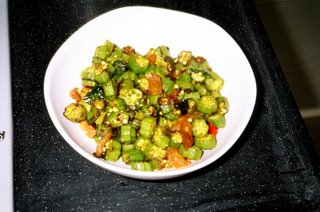
This is how the fish pieces should look once you've shallow-fried them.
:::::::::::::::::::::
The other day as I was walking through Little India I came across a series of Bangladeshi eateries, one of which was called 'Radhuni' the name reminded me of the 'Radhuni' eatery on Free School Street in Calcutta, also run by Bangladeshis settled in Calcutta. When I was a student, we'd go to Radhuni sometimes and eat maccher kalia and rice. Radhuni was next door to Prince, another small dive with Bangla roots. On a recent trip back home I noticed that Radhuni had disappeared and Prince was looking shabbier than what I remembered it as.
It's difficult to cook traditional Bengali dishes away from home mostly because it isn't easy getting typical Bengali spices and cooking with the very pungent flavored mustard oil sometimes just isnt an option in a fancy rented apartment. So I've learnt to adapt my favorite Bengali dishes, making them easier to prepare and just as flavorful.
This simple maccher jhol (fish curry) takes about 20 minutes to prepare and along with plain boiled rice is a Bengali staple. Use any nice white fish -- here in Singapore I often use a local fish that looks a bit like rui maach; milk fish can also be used. Just don't use a very strong flavored fish like salmon as the point of this dish is the gravy (jhol) that the fish absorbs.
A note on paanch phoron: this is a typical Bengali spice and is basically five spices -- onion seed, fenugreek, fennel, radhuni (i don't know the English name for this) and cumin -- dry roasted and blended together. The spice can be bought ready mixed at Indian or Bangladeshi grocery stores that specialize in Bangla ingredients.
The Recipe
3-4 fish fillets cleaned, washed and patted dry on paper towels then rubbed with some salt and tumeric powder
1 tomato diced; another quartered
1 inch piece fresh ginger cut into small pieces
3-4 green chillies cut into small pieces; 2-3 slit whole green chillies
1 and a 1/2 teaspoon coriander powder
1 potato sliced into thick rounds
1 teaspoon paanch phoron
vegetable oil
1 teaspoon tumeric
salt
1 teaspoon sugar
In a frying pan that can be covered, heat about 2 tablespoons of oil till smoking hot then shallow fry the prepared fish fillets about 2-3 minutes each side till nice and golden and cooked through. If necessary cover the fish while it fries as some fish like milkfish tend to sputter dangeroulsy when fried in hot oil. Remove fried fish and keep aside.
Put the garlic, chillies and some salt in a mortar. Grind well into a thick paste; add the diced tomatoes and coriander powder and grind some more till tomatoes are mashed and the paste is thick but not too coarse.
Heat the frying pan (you may need to add a little more oil) and when nice and hot add the paanch phoron and then the ground spice paste. Take care not to burn the paanch phoron as this will make the curry bitter. Fry well till the paste is fragrant and oil separates from the paste.
Add the fish pieces and some more salt, sugar and fry till fish is well covered in the paste. Add about two cups warm water and the potato slices, quartered tomato and slit whole chillies. Bring to the boil, then reduce heat and simmer 10-12 minutes till potatoes are done.
Serve hot with steamed white rice or luchis.
 I've modified this typical south Indian vegetable preparation with the addition of sun-dried tomatoes. I like using the dried tomatoes because it adds a richer flavor to the dish and these tomatoes are readily available from the supermarket any time of the year.
I've modified this typical south Indian vegetable preparation with the addition of sun-dried tomatoes. I like using the dried tomatoes because it adds a richer flavor to the dish and these tomatoes are readily available from the supermarket any time of the year.










